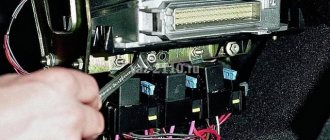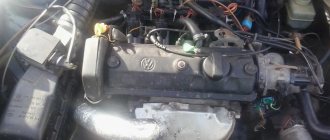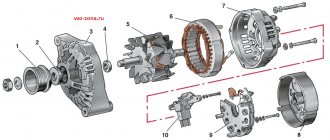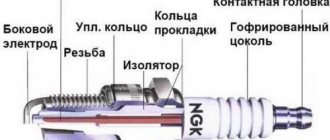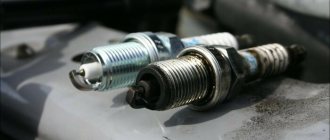Probably every car enthusiast has encountered such a problem when, after a short period of inactivity, the car suddenly refused to start. And there may be a dozen reasons for this. The most likely one is a dead battery. However, something else can happen - for example, the car stopped starting due to fuel getting on the spark plugs. And not only on carburetor cars, spark plugs are filled. VAZ-2110 (injector), Priora and many other cars are also not immune to this problem.
Even foreign cars are not an exception. That is why in today’s article we will look at why the spark plugs on the injector are flooded and how to fix this problem.
Causes
The most common of them is the incorrect operation of the car's electronic unit. What’s most interesting is that the spark plugs on the injector are filled more often in winter at subzero temperatures than in summer. And this is not an anomaly. There are objective reasons for this. As the temperature drops, mixing the fuel-air mixture becomes more difficult because a large amount of oxygen requires a large volume of gasoline in cold air. In this regard, the electronic control unit sends a signal to the fuel injectors, thereby increasing the amount of fluid supplied. This is the main reason why the candle floods.
What is happening in the engine at this moment? The injectors supply gasoline to the combustion chamber of the engine, while the starter tries to create the necessary compression in the cylinders, while at the same time trying to produce a spark to generate a flash. At the same time, we should not forget about the quality of our fuel - a lot of impurities and dirt significantly worsen the operation of the injectors, hence the corresponding troubles.
With ideal compression, the spark plugs can easily start even with a minimal impulse, but this only happens on new cars. Therefore, it fills spark plugs on the injector most often on cars more than 3-5 years old.
Symptoms of a problem
If the spark plugs fail, there will be no spark. Consequently, the fuel mixture will not be able to ignite, the engine will freeze and show no signs of life.
There are several telltale signs that may indicate poor spark plug performance.
- The engine starting procedure gets worse. The starter turns, but the motor itself does not respond;
- Fuel consumption increases;
- CO emissions increase;
- At idle and while driving, the engine begins to jerk the car;
- The dynamic performance of the car drops, it is not possible to raise the speed to the required maximum, the engine power noticeably decreases, etc.
Article on the topic: Ball joint on the VAZ 2109: choosing a new one and replacing it
But all these are indirect reasons, since they do not directly indicate the failure of the spark plugs. You can verify their malfunction only by checking.
Problem solving
How to fix this problem? The operating manual for modern cars says something like this: “If the spark plugs on the injector are flooded, you need to unscrew them and dry them thoroughly.” In this case, the starter must be cranked for 10-15 seconds after removing these elements. Next, the dried spark plugs are inserted back into their original place, and after that the engine starts. This is the way the car manufacturer offers us to fix the problem.
But there is another, popular, way to eliminate this problem. If you fill the spark plugs when they are cold (injector), before unscrewing and drying them, you should start the engine as follows. For injection internal combustion engines, the gas pedal is pressed to the floor all the way, the starter cranks the engine for about 10-15 seconds, then the pedal is released. In most cases, this helps to start the car. The essence of these manipulations is to blow air through the “wet” spark plugs (in this case, the fuel supply is completely shut off).
avtoexperts.ru
If you get behind the wheel and find that the engine won’t start, don’t be discouraged. Maybe your spark plugs are just flooded. This problem especially often arises in the winter season, which already causes a lot of trouble for motorists. Most often, spark plugs are filled with gasoline, sometimes with oil. You need to understand how and why this happens, then you can act proactively and avoid a situation where the car cannot be started. Well, if everything has already happened, then it would be nice to know how to return the spark plugs to working condition and start the engine.
Symptoms and mechanism of flooding
When it comes to flooded spark plugs, it does not matter what we are dealing with: a carburetor or an injector. Both engine types are not protected from flooding. Its consequences are unpleasant because they do not allow the engine to start. At the same time, it may smell like gasoline, the starter may crank, but most importantly, traces of a foreign substance can be easily detected on the spark plugs themselves: gasoline, oil or carbon deposits. To assess the condition of the spark plugs, they must be unscrewed.
The filling mechanism is quite simple. The fuel supplied to operate the engine does not ignite. The spark plugs get wet, and this prevents the engine from starting normally.
Seven reasons to fill candles when cold
If you decided to start the engine, but nothing happened, and instead you found spark plugs stained with gasoline, then this could happen for the following reasons:
1. Insufficiently charged battery. Even if at positive temperatures the battery coped with its tasks without problems, the onset of frost could radically change the situation. It is enough for the battery to be discharged by 50%. Even with this indicator, there may not be enough power to start the engine.
2. Cylinder wear. A worn-out engine cannot run perfectly, so it is not surprising that new engines have insufficient cylinder compression. In combination with other factors, this can lead to flooded candles.
3. Old spark plugs. It is not for nothing that this part is consumable and requires regular monitoring and, if necessary, replacement. If you do not change the spark plugs for a long time, then defects appear on them, which can prevent spark formation, which is so necessary to start the engine.
4. Malfunction of structural elements of the ignition system. Faulty wires and soured contacts can be one of the reasons that caused spark plugs to flood.
5. Poor quality fuel. This does not mean that you were deceived and sold bad gasoline. The point is that in winter there are a number of factors that can negatively affect the quality of fuel.
For example, the formation of condensation in the fuel tank and its entry into gasoline. As a result, the fuel does not ignite at the right time, which becomes one of the reasons for “wet” spark plugs.
6. Unsuitable engine oil. If we are talking about winter, then you need to use oil with a viscosity that will not load the engine, otherwise this will become another factor creating conditions for flooding.
7. Accumulation of carbon deposits in the combustion chamber. Short trips in the city do not allow the engine to “breathe”. As a result, carbon deposits form, which settles in a thick layer on the walls of the combustion chamber. The mobility of the piston rings decreases, and with it the compression in the cylinders. As a preventative measure, it is necessary to run the engine at high speeds. Sometimes, to return the piston rings to mobility, special flushing of the system is required.
Sometimes it happens that there is a spark and the starter rotates normally, but gasoline still pours out. In this case, it is necessary to carry out diagnostics to determine the serviceability of the spark plugs. In rare cases, the problem may be in the ECU itself.
Engine oil on spark plugs
Gasoline is not the only liquid that can be found on spark plugs. Sometimes they are filled with motor oil. Again, this can happen to both the injector and the carburetor. It is important which part of the candle contains traces of oil. If the top of the spark plug is dirty, the problem is most likely related to the valve cover gasket. If oil is observed at the bottom of the spark plug, then you need to take care of the condition of the engine and the compression in it. Read about the reasons for the appearance of oil on candles in the article
First aid when pouring candles
If you follow the manufacturer's instructions, the entire procedure for solving the problem can be presented in a few steps.
Step 1. Unscrew the spark plugs.
Step 2. Dry the wet part.
Step 3. Crank the engine without spark plugs for 10 seconds.
Step 4. Put the dry part in place.
Step 5. Trying to start the engine.
But the driver does not always have time for these simple actions. Flooding of spark plugs is an unexpected situation, and what to do if you don’t have time to tinker with wet parts?
Car enthusiasts have one more method in stock for such a case: starting the engine with cylinder purging. It is performed as follows. We are talking about an injection engine.
Press the gas pedal all the way, then crank the starter for about 10 seconds. Return the gas pedal to its original position. Thanks to this manipulation, more air enters the cylinders, which allows the spark plugs to dry out.
If the “folk” method does not help, then there is no escape from the need to unscrew the candles and spend a certain amount of time drying them. The unscrewed part is cleaned. You can dry it with a hairdryer, on an electric or gas stove.
True, there is an even more effective way: buy new candles. Any drying will shorten the service life of wet candles. It is only a temporary measure, so if it is possible to replace the spark plugs with new ones, then in this case this will be the best option.
Prevention
By observing the following conditions, you can avoid flooding at any time of the year:
• Monitor the battery charge;
• Monitor the serviceability of all elements of the ignition system;
• Use appropriate motor oil in winter;
• Refuel with high-quality fuel;
• Clean the injector nozzles in a timely manner;
What to do if the engine does not start after this?
In this case, these elements should be dried. In general, the spark plugs that go into injection engines are no different from those that are installed on carburetor engines, so the method described below can be considered universally applicable.
This method consists of the following. After unscrewing, the candles are cleaned with a special metal brush to remove accumulated carbon deposits, and then dried with a regular hairdryer. Alternatively, you can hold them over the burners of your gas stove. Next, the gap is checked, and the dried spark plugs are screwed back into place. In this case, the engine will definitely start at any temperature.
Gap
When performing a preventive check of spark plugs or while searching for the causes of an unstable engine, it is recommended to check the gap between the electrodes.
- If the gap is larger than normal, the spark will form more than usual, the mixture will begin to ignite more strongly, and the flow rate will be more stable. In this case, failures in the operation of the motor may occur.
- If the gap is smaller than required, the spark will begin to appear earlier than required. The small spark energy is not capable of effectively igniting the fuel mixture. This increases fuel consumption, but reduces engine power and worsens dynamics.
The gap between the electrodes on the injection VAZ 2110, according to the manufacturer’s recommendations, ranges from 1 to 1.13 millimeters.
Gap measurement
Setting the gap
The first step is to check whether the gap really deviates from the norm, and then take appropriate action. So, let's begin.
- Get to the spark plugs, having first disconnected the high-voltage wires from them.
- Use a feeler gauge to measure the distance between the two electrodes of your spark plugs. Special probes are sold that look like a folding knife.
- Take a feeler gauge whose blade is exactly 1 mm thick.
- Insert the probe into the gap between the electrodes.
- Normally the blade should go in with a slight pinch, but you don't have to use much force to get it in.
- If the blade is too loose, then the gap is too high. You will need to lightly press the upper electrode against the lower one until the required distance is formed.
- If the blade is difficult to fit into the gap, then it was smaller than required. In this situation, you will have to do the opposite, bend the electrode slightly.
Adjusting the distance
When increasing or decreasing the gap, do not apply too much force, otherwise you risk breaking the element. In this situation, there is nothing left to do but change the spark plug.
What to do if you fill the spark plugs on the injector every day?
It happens that gasoline gets there every morning. Of course, even the most patient car enthusiast will quickly get tired of carrying out such drying work every day, so in this situation we send the car for diagnostics. You can order this service at a service station, or you can do it yourself. In the latter option, you should diagnose the spark plugs for the quality of spark generation, its output from the ignition coil, check the cleanliness of the injectors and the operation of the Hall sensor. Perhaps the problem is hidden in one of these parts.
Features of starting a car in cold periods
In cold weather, before starting, you must first load the battery, then disconnect it for a while. After waiting a few minutes, you can try turning the starter to start the engine. If you fail to start the car on the first try, then in order not to fill the injector, you must wait a few more minutes. If all preventive measures were carried out in full before the frost, then there should be no problems with filling fuel.
We can list several conditions that are considered optimal for normal operation of the injector:
- presence of a working starter;
- maximum battery charge. The battery is powerful and in good condition;
- seasonal lubricant is used;
- spark plugs and high voltage electrical circuits must be in perfect condition;
- clean, adjusted nozzles are installed;
- The gas tank is filled with high-quality fuel.
There is an opinion among experienced drivers that driving a car along a highway at a speed of 120 km/h promotes self-cleaning of automobile systems, including the fuel system. You can also run the engine at 5000 rpm for about 10 minutes in the morning. The effect is similar to racing on a track.
It is believed that when high pressure is created in the systems, self-cleaning occurs. These measures can only be carried out if the car is in good condition and a significant increase in pressure in the systems will not harm it.
What steps do you need to take to get started?
The question arises, what to do if the car is not old, all systems are in order, but in the cold it refuses to start? When turning the spark plugs out, it turns out that they are wet. As already mentioned, in the cold season, the cause of this phenomenon may be weak compression, low-quality fuel or a weak battery.
Let's look again at the manufacturer's instructions. The book on car operation defines the following algorithm of actions:
- Turn out the spark plugs.
- Wipe them thoroughly and dry them.
- Run the starter for a few seconds.
- Put everything in place.
Often, car owners clean the injector using various fuel additives. This is not recommended at all, firstly, the quality of the fuel mixture is lost, which negatively affects the operation of the entire piston group, and secondly, the injector should be cleaned using special equipment.
Experienced drivers carry several sets of spare spark plugs with them . The quality of the spark produced depends on the technical characteristics of this ignition component. There is no point in saving on candles, their cost is not that high, and low-quality candles can cause a lot of problems.
Under what conditions will the spark plugs not be filled with gasoline?
In order to avoid suddenly encountering a similar problem in the garage in the morning, you should always keep your car in good technical condition. Conditions that exclude the occurrence of this problem are:
- Defective starter.
- Well charged battery.
- Availability of high-quality spark plugs and high voltage wires.
- Timely cleaning and adjustment of fuel injectors. It is not recommended to use special additives in the tank for this. It is best to clean injectors using equipment designed for this purpose (in which case you can make such tools yourself). Floods spark plugs (VAZ-2110 - injector, among others) often for this very reason.
- Availability of high-quality gasoline. It is very difficult to find it at our gas stations, but to avoid trouble, find one gas station network that sells really high-quality gasoline, and constantly refuel there. Rest assured, the risks of premature contamination of the fuel system will be reduced tenfold.
Finally, we note another popular method of prevention. According to it, you should regularly (3-4 times a week) increase the engine speed to the red scale (4.5-5 thousand revolutions) for 10 seconds so that self-cleaning of carbon deposits in the combustion chamber of the internal combustion engine occurs.
Thus, we examined the factors of fuel formation in candles and learned ways to solve this problem.
Choice
The choice of candles today is quite extensive. But we’ll talk about which ones are used for the VAZ 2110 and what can currently be considered the best choice for your car.
Candles differ from each other mainly in the material from which the electrodes are made.
| Candle type | Peculiarities |
| Copper | These are classic spark plugs for VAZ, installed by the factory. The operating life is up to 50 thousand kilometers. Some of them are coated with yttrium alloy to increase the reliability of the electrode. |
| Platinum | They are characterized by increased resistance to temperature fluctuations and corrosion, which has a positive effect on the service life of the elements. Such elements are capable of operating up to 90 thousand kilometers |
| Iridium | The characteristics are in many ways close to platinum candles; today they are considered the most durable and high-quality. Safety margin - about 90-100 thousand kilometers |
The service life may increase or decrease depending on the care, conditions of use of the vehicle, and the quality of the fuel being poured.
Platinum candle






